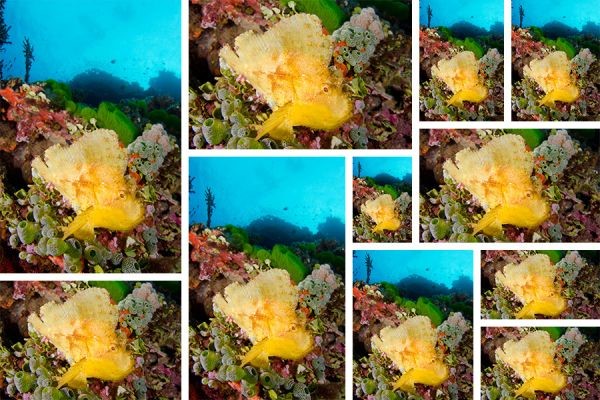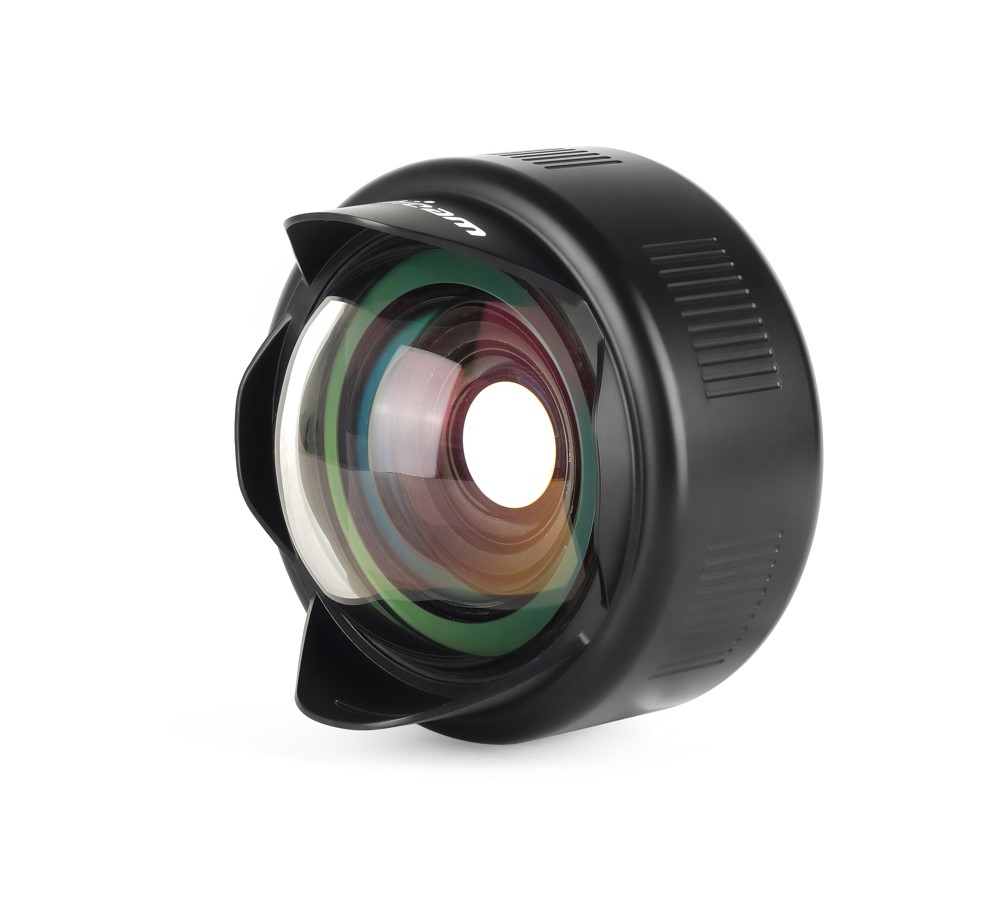文章分享 | 水下摄影基础构图
2021-12-22
来源:
https://www.divephotoguide.com/underwater-photography-techniques/article/underwater-photographer-s-guide-composition/
In its most basic definition, composition is the arrangement of the elements of your image as part of the whole. Composition, as well as lighting, is the key way that photographers put subjective input into an image. Therefore, it’s important to put your own creative touch on composition. There is no right or wrong to composition. It’s definitely an art, not a science.
在最基本的定义中,构图是将图像的元素作为整体的一部分进行排列。构图和灯光,是摄影师将主观感情输入到图像中的关键方式。在构图中加入自己的创意是很重要的。构图是一门艺术。
“There are no rules for good photographs, there are only good photographs” – Ansel Adams
好照片没有固定的评判标准– Ansel Adams
That said, there are a few tried and true composition rules that often make images more visually pleasing to audiences. Proper composition will emphasize the subject to the viewer.
也就是说,有一些行之有效的构图规则,可以使图像在视觉上更讨人喜欢。适当的构图能使观者更清楚地看到主题。

Frog Fish wide angle underwater photograph by Matt Weiss
广角水下镜头下的躄鱼-- Matt Weiss
Composition Doesn’t Just Happen
构图不是凭空出现的,需要思考
Beginner photographers often see a subject they like and just start shooting. Taking some time to think about how the subject would look best in the frame and within its environment can dramatically increase the impact of the image.
新手摄影师经常是看到了他们喜欢的拍摄主题就开始拍摄。花多些时间思考如何让拍摄对象在画面中看起来是最合适的,这可以大大提高照片的水平。
This guide will provide you with some basic composition tips that will help improve your images. Many of these tips are not specific to underwater photography and will be relevant to all of your photography efforts. While these are basic guidelines that work, they are merely a starting point for you to eventually develop your creative vision.
本指南将为您提供一些基本的构图技巧,有助于改善您照片的质量。这些技巧中有许多不是专门针对水下摄影的, 而是与所有的摄影工作相关的。这些是基本指导方针,但这仅仅是你培养创造性视野的一个起点。
Camera Orientation: Portrait or Landscape
相机的方向:横向或者纵向拍摄
There are two general orientation options of our camera, vertical and horizontal. When we shoot vertically, it is referred to as “portrait” and horizontal images are referred to as “landscape”. Be sure to approach every subject with an open mind. Feel free to shoot both portrait and landscape images of the same subject. Sometimes you might surprise yourself and find the orientation that you wouldn’t have originally chosen is better than you thought.
相机有两种方向的选择,垂直和水平。垂直拍摄为“纵向”,水平拍摄为“横向”。一定要有开放性思维去对待每一个拍摄主题。可以对同一主题同时拍摄纵向和横向两个方向。你可能会发现,你没选择的另一种拍摄方向拍出来的效果比你想象中的要好。
Enough Fish Butts and Dorsal Fins
不要拍摄太多的鱼的背面和背鳍

Fish tail underwater photograph
水下的鱼尾照片
When diving, we are in a three dimensional world, and when swimming over a reef, we are usually looking down on the life below. Resist the urge to just start shooting the top of the fish. You usually need to get below the fish, or at least at eye level, in order to make a pleasing image. Therefore, always remember this when composing your shots - get low and shoot up. No more dorsal fin shots!
潜水时,我们处在一个三维世界中,当我们在礁石上游泳时,我们的视线通常是往下去看水下的生物。抑制住想要拍摄鱼的顶部的冲动。你通常需要游到鱼的下方,或者至少在鱼眼睛的水平位置,这样才能拍出好看的照片。因此,在构图时,一定要记住这一点——把你的位置放低一点,向上去拍摄。不要再拍背鳍了!
Another common mistake is scaring the subject and then chasing after it to get the shot. Fish swim faster than you. You will never catch up. You will end up with fish butt shots. Be patient and take the time to wait until the subject is facing you. As to be discussed later, eyes are the most important part of the subject. A viewer can't relate to a subject without eyes.
另一个常见的错误是吓到了拍摄对象,然后追着拍。鱼游得比你快,你永远也追不上。耐心点,花点时间等待,直到对方面对你。后面会讨论到,眼睛是这个构图主题中最重要的部分。没有眼睛,观众无法与主题产生共鸣。
Don’t Cut Off Parts of Your Subject
不要把你拍摄的主题裁剪掉一部分
Avoid cutting off parts of your subject with the edges of the frame. Sometimes it is okay to not include the entire subject in the photo. This is usually true for creative macro shots where the frame is filled with a strategic part of a subject. If you can’t include the entire subject in the shot, it will only work with a creative composition, like a face portrait or eye shot. However, cutting off part of the subject when the shot was clearly meant to include it in its entirety will result in an image that subconsciously reads as being incomplete.
避免用边框去裁剪掉你的主体部分。有时在照片中不包括整个主题也可以,这通常是创意微距拍摄,整个画面充满了一个主题的最优部分。如果你不能在照片中包含整个拍摄主题,可以做一个创造性的构图,如脸部肖像或眼睛。但是,当拍摄的目的很明确时,剪掉了主体的一部分,会让照片在潜意识里被认为是不完整的构图。

Cuttlefish underwater photograph by Matt Weiss
Matt Weiss拍摄的水下乌贼
This is a well lit, sharp image of a cuttlefish, but unfortunately part of the animal is cut off. Make sure you get the entire subject in the frame
这是一个光线充足、清晰的乌贼照片,但可惜的是,动物的一部分被剪掉了。
确保你拍到的是整个拍摄对象
Focus On the Eyes
聚焦在拍摄主体的眼睛上
Some people say that the most important rule of wildlife photography is making sure the eyes of the subject are in sharp focus. Out of focus eyes means that you will lose the focus of your audience. This makes sense as humans show a lot of expression in our eyes. When we talk to one another, we look at each other in the eye. Therefore, it’s only natural for us to be drawn to the eye in the image. If you are shooting with large apertures or with high magnification macro lenses that have shallow depths of fields, it is very important that you ensure the focus point is on the eye. Luckily, eyes usually offer good contrast and auto-focus can pick them up well. By locking the focus on the eye, and then composing your image, you have the best chance of keeping this important feature sharp.
有人说,野生动物摄影最重要的规则是确保拍摄对象的眼睛在清晰的焦点上。失去焦点的眼睛意味着你将失去你的观众的焦点。确实,因为人类的眼睛里有很多表情。当我们和对方说话时,我们会看着对方的眼睛。因此,在照片中被眼睛吸引是很自然的。 如果你是用大光圈或高倍微距镜头拍摄,但景深较浅,确保焦点在眼睛上是非常重要的。幸好,眼睛通常有很好的对比度,自动对焦可以很好地捕捉它们。把焦点锁定在眼睛上,然后构成你的图像,

Goby on coral underwater photography by Matt Weiss
Matt Weiss拍摄的虾虎鱼
Even if the rest of the subject is out of focus, it's the eyes that need to be sharp
即使拍摄对象的其他部分没有聚焦,也需要对焦到它的眼睛
Give Fish Room to Swim
给鱼留出足够的拍摄空间
Any subject that is actually, or potentially could be, in action should be placed far from the edge with room to “swim into the frame”. In other words there should be more space in front of the swimming fish then behind it. If the moving object is close the edge, it looks like it may “swim” of the edge, which subconsciously makes the viewer uncomfortable.
任何正在或可能正在活动的物体都应该在远离画面边缘的地方,以便有足够的空间让它们“游进画面”。 换句话说,游动的鱼的前面应该比后面有更多的空间。 如果移动的物体靠近画面的边缘,看起来就像是在边缘“游动”,会让视角看上去不舒服。

Fish swimming out of the frame
鱼游出了画面
Here the fish appears to be swimming out of the frame, which is uncomfortable to the viewer
鱼似乎正在游出画面,这看起来并不好看

Fish underwater photography by Matt Weiss
Matt Weiss拍摄的鱼
This is the same fish as above, but the image is cropped so that fish is swimming into the frame, which feels much more natural
这跟上图的鱼是一样的,但是图像被裁剪了,鱼像是游进画面一样,看起来感觉更自然
The Rule of Thirds: Don’t Aim For the Bulls Eye
三分法:不要把构图的重心放在正中间
The rule of thirds might as well be called the golden rule of photographic composition. This rule dictates that an image should be divided up into thirds both horizontally and vertically, and the important elements of the image should fall on or close to the intersections. Aligning key compositional elements of the image with these intersection points will make an image more interesting.
三分法可以说是摄影构图的黄金法则。 这一规则要求图像应该在水平和垂直方向上被分成三份,图像的重要元素应该落在或接近交叉点。将图像的关键组成元素与这些交叉点对齐将使图像看起来更有趣。

Rule of thirds underwater photograph by Matt Weiss
三分法水下摄影-- Matt Weiss
A focal point of the image, the divers eyes, were aligned close to a point where the lines intersect to make the image more interesting
照片中的一个焦点,潜水员的眼睛,被排列在靠近线相交点的地方,使图像更有趣
You will notice that most great landscape images have key subject matter offset from the middle and do not have the horizon smack dab in the middle, but closer to one of these lines. The rule is mainly applied so photographers avoid placing the main point of interest in the middle of the frame, referred to as “bulls eyeing,” which normally produces a boring image.
大多数优秀的风景图片中,关键的主题都是从中间开始偏移。像地平线不会是正好在中间,而是更接近这些三分法中的线条之一。这一规则主要是为了让摄影师避免将重点放在画面的正中间,这样拍出来的照片会很平淡。

Horizon rule of thirds composition by Matt Weiss
Matt Weiss---地平线三分构图法则
Here the horizon line was placed in the bottom third of the image, rather than in the middle
地平线被构图在图像的底部三分之一,而不是在中间
Lines, Shapes and Colors
线条,形状和颜色
Diagonal Lines
对角线
Adding a diagonal flow to the placement of your subject(s) and/or background, can be one of the major ways to make your images more dynamic, creating more interest for the viewer.
在你的主题和/或背景的位置添加一个对角线流,可以使你的图像更动态,创造更多有趣的看点。

Ornate ghost pipefish by Matt Weiss
Matt Weiss所拍摄的尖嘴鱼
Here the ornate ghost pipefish is shot to utilize diagonal lines in the compositions
在构图中利用对角线拍摄
Non-Diagonal Lines
非对角线的线条
Lines are more common in the underwater world than you may think. Using these lines effectively can help improve an image's composition.
线条在水下世界比你想象的中的要常见得多。有效地使用这些线条可以帮助改善图像的构图。
Different types of lines have different qualities that can change the impact of the image. For example, vertical lines imply strength and power. If you wanted to emphasize the size of something, say, large barrel sponges or massive stalactites, shooting them vertically can help.
不同类型的线条有不同的效果,可以改变图像的影响。例如,垂直线意味着力量。如果你想强调某物的大小,比如大海绵动物或大块钟乳石,垂直拍摄会更佳。

Ornate ghost pipefish underwater photograph by Matt Weiss
Matt Weiss拍摄的尖嘴鱼















 粤公网安备 44030402001314号
粤公网安备 44030402001314号